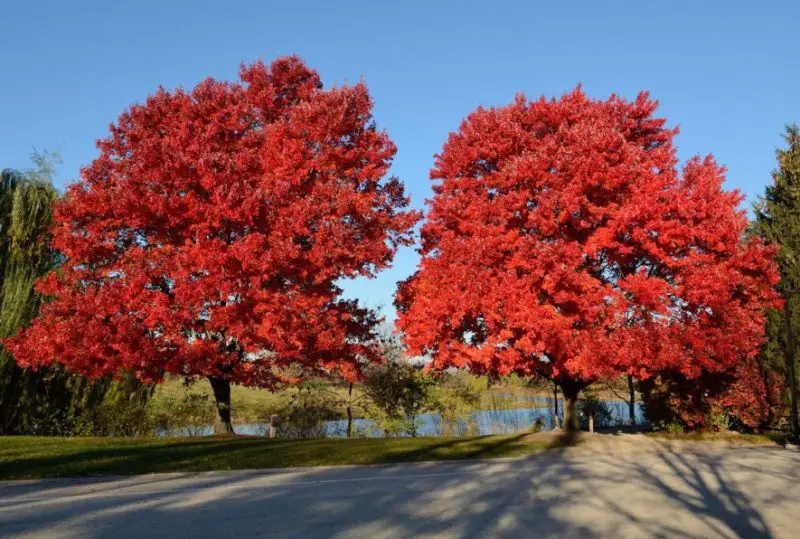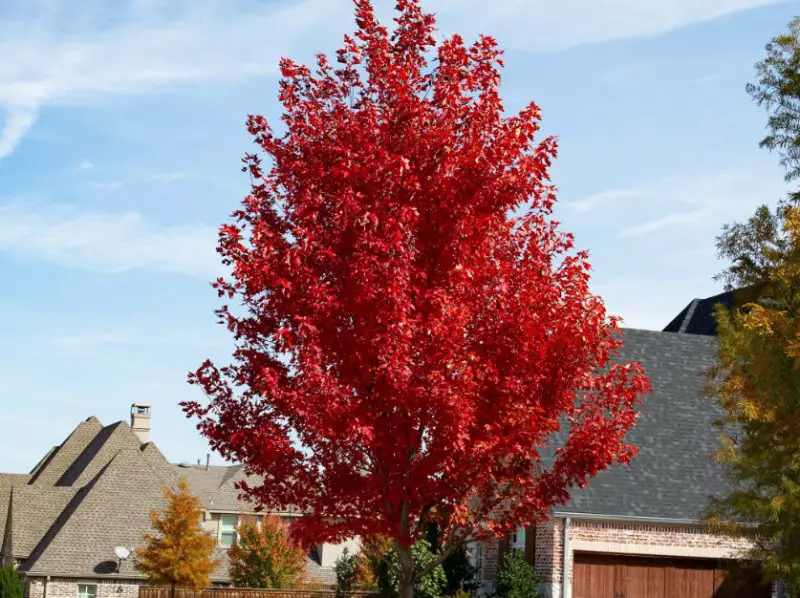Renowned for its radiant fall foliage and graceful presence in the landscape, the October Glory maple tree is a beloved species cherished by many gardeners and enthusiasts.
In this detailed article, we will explore everything you need to know to ensure the health and vitality of your October Glory maple, from planting and propagation to pruning and pest management.
About October Glory Maple Tree

The October Glory maple tree, scientifically known as Acer rubrum ‘October Glory,’ is a radiant cultivar of the red maple. It belongs to the Sapindaceae family. This tree is renowned for its robust growth, reaching a mature height of 40-45 feet and spreading out 30-35 feet wide. It makes an imposing and graceful presence in any landscape.
Its adaptability to both full and partial sun exposure allows it to thrive in a variety of settings. From spacious suburban lawns to more confined urban spaces, it grows well, provided it is planted in well-drained soil. The soil’s pH should be acidic to match the tree’s natural preferences. This ensures it grows healthy and strong.
Hardy in USDA zones 4-9, the October Glory maple tree is a resilient and versatile species. It is capable of withstanding a range of climatic conditions found across much of the United States. Its native roots in North America have made it a popular choice for both ornamental and practical landscaping purposes. It is celebrated not only for its lush, green foliage throughout the spring and summer but also for its spectacular autumn display.
As the name suggests, the ‘October Glory’ variety is particularly noted for its vibrant red leaves. These emerge later in the fall, providing a prolonged and breathtaking display of color. This occurs when many other trees have already shed their leaves. This distinctive characteristic makes the October Glory maple a cherished addition to any setting. It encapsulates the essence of the autumn season with its splendid hues.
October Glory Maple Tree Care Guide

Caring for an October Glory maple tree is relatively straightforward, but following a few key guidelines can ensure its health and vibrancy:
Firstly, ensure the tree is planted in soil with good drainage. While it can tolerate various soil types, sandy soil may require more frequent watering to maintain optimal moisture levels.
For the most stunning autumn color display, position the tree in an area that receives full sun.
Be cautious when choosing the planting location. Avoid placing the tree near sidewalks and driveways where its shallow roots could potentially disrupt the hardscape over time.
Generally, refrain from fertilizing the tree unless it shows signs of reduced vigor, particularly as it matures.
When it comes to pruning, less is more. Perform minimal pruning at the end of summer or early fall to remove any dead or damaged branches and promote healthy growth.
Light
The October Glory maple tree is quite adaptable when it comes to light requirements. While it can tolerate partial shade, its autumn color display is likely to be most spectacular when grown in full sun.
However, environmental conditions play a role, particularly as you move further south within its range. In these regions, providing the tree with a bit of afternoon shade, especially during its establishment phase, can be beneficial. This helps mitigate potential stress and ensures the tree’s successful adaptation to its surroundings.
Ultimately, striking a balance between sunlight exposure and shade can optimize the October Glory maple’s growth and enhance its vibrant fall foliage.
Soil
The October Glory maple tree exhibits remarkable adaptability to various soil types, thriving in a range of conditions. Whether it’s the perfect loam mix, heavy clay, or sandy soil, this resilient tree can survive and flourish. However, it’s essential to note that in sandy soil, additional watering may be necessary to maintain adequate moisture levels.
While the October Glory maple is relatively tolerant of different soil compositions, there are certain conditions to avoid to ensure optimal growth and vibrant fall color. One crucial factor to consider is soil pH. Avoid planting this tree in alkaline soil if you desire the iconic red hues of its autumn foliage. Alkaline soil can result in pale yellow leaves instead of the desired fiery red display.
Water
The October Glory maple tree has specific preferences when it comes to water, favoring soil that remains evenly moist. Remarkably adaptable, it can even endure brief periods of soggy soil, such as during seasonal flooding, earning it the common name “swamp maple.” However, for optimal long-term growth, providing good drainage is essential.
While the October Glory maple can withstand occasional waterlogging, it performs better when planted in soil with proper drainage. Additionally, it’s important to note that this species is not particularly drought-tolerant. In regions at the southern end of its range, especially in well-drained soil, reliable irrigation is necessary to ensure its health and vitality.
Temperature and Humidity
October Glory maple trees are widely prized for their exceptional resilience to cold, which makes them a desirable species in areas with diverse temperatures. It is noteworthy for its remarkable ability to withstand the heat and humidity typical of the southern United States.
It is important to remember that, although while it can function rather well in zone 8, its appropriateness decreases as you enter zone 9. While it can live in zone 9, other tree species are more adapted to this kind of climate.
Consequently, even though October Glory maples can tolerate a variety of temperatures and humidity levels, it is essential to think about other landscaping solutions in zone 9 regions in order to ensure the best possible development and vitality.
Fertilizer
When it comes to fertilizing your October Glory maple tree, patience is key, especially during its initial establishment phase. It’s advisable to refrain from fertilizing during the first year, allowing the tree to focus on rooting and becoming firmly established in its new environment.
Even after the initial year, maple trees generally don’t require extensive fertilization. However, if you notice signs of reduced vigor in an older tree or if you’re aiming for accelerated growth, a slow-release, nitrogen-rich fertilizer can provide a beneficial boost. Applying this fertilizer once a year can help rejuvenate the tree and promote healthy growth.
Before making any amendments to the soil, it’s crucial to conduct a soil test. This ensures you understand the specific needs of your soil and can tailor any fertilization efforts accordingly. Soil tests, available through local county extensions, provide valuable insights into your soil’s composition, allowing you to make informed decisions about how best to support the health and vitality of your October Glory maple tree.
Pruning
When it comes to pruning your maple tree, less is often more. Minimal pruning is recommended, ideally when branches are still small. It’s essential to remove any branches that form narrow angles with the trunk or other major branches, as wider angles provide greater strength and reduce the risk of breakage during storms.
When making pruning cuts, aim to cut just outside the branch collar to facilitate proper wound healing. The optimal time for pruning is at the end of summer or in autumn, as pruning during spring may result in sap bleeding. By following these pruning practices, you can help maintain the health and structural integrity of your maple tree.
Different Types of October Glory Maple Trees
Maple trees, including native varieties like Acer rubrum and Japanese maples like Acer palmatum, are cherished in North American landscapes for their stunning fall colors and diverse forms. Careful consideration is crucial when choosing the right tree, as they vary in size, leaf color, and some may be invasive.
Examples include the Autumn Blaze red maple, reaching 40 to 55 feet in height, and the Inaba Shidare Japanese maple, a small tree with weeping foliage that transitions from dark purple to bright red. Another standout is the Crimson Queen Japanese maple, known for its crimson foliage, standing 8 to 10 feet tall and wide.
Propagating October Glory Maple Trees
Propagating an October Glory maple tree from cuttings offers a cost-effective means of expanding your landscape with this beloved species. Here’s a step-by-step guide to propagating an October Glory maple from cuttings:
Step 01: Gather your supplies, including pruners, work gloves, rooting hormone powder, potting soil, a clear plastic bag, sticks, isopropyl alcohol, and a container.
Step 02: Fill a container with potting soil and create a 2-inch-deep hole in the center. Water the soil and set it aside.
Step 03: Sterilize your pruners with isopropyl alcohol and select a healthy-looking branch with new growth. Cut a 4-inch-long section from the tip of the branch.
Step 04: Strip off any leaves from the bottom half of the cutting, leaving two leaves on the top half.
Step 05: Use a blade to scrape off 2 inches of bark from the bottom of the cutting, all the way around.
Step 06: Dip the bare, 2-inch section of the cutting into rooting hormone powder and insert it into the prepared hole in the soil.
Step 07: Suspend a plastic bag over the container using sticks to create a greenhouse tent.
Step 08: Once the cutting takes root, remove the tent and transfer the container to a sunny window.
Step 09: Acclimate the sapling by placing it outside during the day and bringing it inside at night for 10 days.
Step 10: Once hardened off, plant the sapling in the desired location in your landscape.
Overwintering for October Glory Maple Trees
Ensuring the well-being of your October Glory maple tree during the winter months is crucial for its continued health and vitality. If you reside in zones north of zone 3, where the tree is cold-hardy, take proactive measures to protect it from harsh winter conditions.
Apply a 3-inch layer of mulch around the base of the tree to insulate its root zone, providing much-needed protection against freezing temperatures. However, be cautious not to pile the mulch up against the trunk, as this could attract pests like voles, leading to potential damage.
In late fall, conduct a thorough inspection and prune off any dead, damaged, or diseased branches. Avoid fertilizing your tree during this time, as stimulating new foliar growth could make it more susceptible to damage from cold temperatures during the winter.
Pest and disease issues
The October Glory maple tree is generally resilient against pest and disease issues, but it’s essential to remain vigilant and take action promptly if any problems arise to maintain its health. Two common issues to watch out for are leaf spots and scale infestations.
Leaf spot, a fungal disease, manifests as brown spots on the leaves, often appearing first on the lower limbs where humidity is higher. While leaf spot typically doesn’t pose a severe threat to the tree’s health, it can detract from its appearance. To manage leaf spots:
- Regularly inspect the leaves for signs of disease.
- Remove affected branches promptly to prevent spread.
- Take preventive measures such as ensuring proper spacing for air circulation, watering in the morning to allow for drying, and practicing sanitation in the fall.
Scale insects, although inconspicuous due to their immobile nature, can cause damage by sucking nutrients from the plant. These brownish, scabby pests are usually found on the undersides of leaves. Treatment typically involves using an insecticide like organic neem oil to control infestations.
Conclusion
The October Glory maple tree is a stunning addition to any landscape, offering vibrant fall colors and graceful beauty throughout the seasons. By following the detailed care and growing guide provided in this article, you can ensure the health and vitality of your maple tree for years to come.
With proper attention to planting, pruning, and pest management, your October Glory maple will continue to thrive and delight with its majestic presence.






